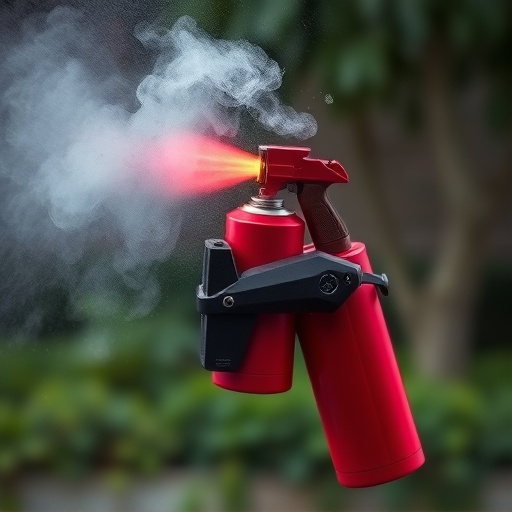Proper storing of pepper spray is key to maintaining its potency, requiring cool, dry conditions away from sunlight and extreme temps. Store it in a secure location, keep out of reach of children, test regularly, and adhere to manufacturer guidelines for optimal effectiveness and legal compliance. Maintain 10-21°C (50-70°F) temp, 60% humidity, and avoid direct light, heat, cold, & moisture for best results.
Defensive spray has emerged as a powerful tool for civilian self-protection. This article delves into the intricacies of pepper spray, its active ingredients, and efficacy. We explore legal considerations governing its civilian use, crucial for responsible ownership. Additionally, we uncover optimal storing conditions to ensure product longevity—a key factor in maintaining maximum effectiveness. Learn effective usage techniques that can empower you with enhanced personal safety.
- Understanding Pepper Spray: Active Ingredients & Efficacy
- Legal Considerations for Civilian Use of Pepper Spray
- Optimal Storing Conditions for Prolonged Product Lifespan
- Effective Usage Techniques for Maximized Protection
Understanding Pepper Spray: Active Ingredients & Efficacy
Pepper spray, a powerful tool for self-defense, contains capsaicin, the active ingredient derived from chili peppers. This compound irritates the eyes and respiratory system, temporarily disabling an assailant. Effectiveness depends on correct usage—aiming for the face and eyes ensures maximum impact.
Proper storage is key to maintaining pepper spray’s potency. Keep it in a cool, dry place, away from direct sunlight or extreme temperatures. Avoid leaving it in a hot car or exposing it to moisture. Following the manufacturer’s guidelines for storing pepper spray will ensure its active ingredients remain potent when you need them most, enhancing your protection during potential threatening situations.
Legal Considerations for Civilian Use of Pepper Spray
The legal landscape surrounding civilian use of pepper spray varies significantly from region to region, reflecting differing societal attitudes and legislative priorities regarding self-defense. While some jurisdictions permit individuals to carry pepper spray for personal protection, others impose strict regulations or outright bans. Before considering pepper spray as a civilian defense tool, it’s crucial to understand local laws, including age restrictions, training requirements, and permissible use scenarios. Non-compliance can result in severe legal consequences, including fines or even imprisonment.
Proper storing of pepper spray is paramount for maintaining its maximum effectiveness. It should be kept out of reach of children and stored in a cool, dry place away from direct sunlight. Many experts recommend storing it alongside other emergency preparedness items, ensuring easy accessibility during unexpected situations. Additionally, understanding the spray’s expiration date and regularly testing its functionality can help ensure its reliability when needed most.
Optimal Storing Conditions for Prolonged Product Lifespan
To ensure maximum effectiveness and prolong the lifespan of your defensive spray, proper storing conditions are crucial. The ideal environment should maintain a consistent temperature between 50-70°F (10-21°C) and relative humidity at around 60%. Avoid extreme heat or cold, as these can degrade the active ingredients. Direct sunlight and moisture should also be avoided; consider storing the spray in a cool, dark, and dry place, such as a locked cabinet or safe. Additionally, keep it out of reach of children and unauthorized individuals to maintain safety.
Regularly inspect your stored pepper spray for any signs of damage, leakage, or changes in color or odor. Check the expiration date and replace the product if it’s passed its prime. Proper storage is not just about preserving the product; it ensures that you have a reliable self-defense tool ready when you need it most.
Effective Usage Techniques for Maximized Protection
Maximizing protection with defensive spray involves proper usage techniques and efficient storage practices. Firstly, it’s crucial to understand the optimal range for application—typically around 2-3 feet (0.6–0.9 meters) away from the target. This ensures the spray reaches the assailant without risking unintended exposure or misdirection onto yourself. Holding the can at a slight angle allows for better control and distribution of the pepper spray, maximizing its effectiveness against the attacker’s eyes and respiratory system.
Storing pepper spray properly is another critical aspect. Keep it in a cool, dry place away from direct sunlight to maintain optimal potency. Ensure the container remains sealed tightly after each use to prevent any loss of effectiveness due to air exposure or evaporation. Store the spray out of reach of children and pets, as accidental discharge can be dangerous for everyone involved. Regularly checking the expiration date is also essential, as pepper spray’s potency decreases over time, necessitating replacement for continuous protection.
Defensive spray is a powerful tool for civilian self-protection, offering a swift and effective deterrent against potential threats. By understanding its active ingredients, legal framework, and optimal storage practices, individuals can ensure maximum effectiveness when it matters most. Mastering proper usage techniques further enhances its reliability, providing peace of mind in an unpredictable world. Remember, responsible ownership and knowledgeable application are key to making defensive spray a valuable asset for personal safety.
